 Your new post is loading...
 Your new post is loading...
Let’s dive into one of the more recent mentions. In our first graph, Nordstrom sees the highest engagement spike for their February mention by Trump. So how is the current controversy playing out for the brand on social media? Over 3.45 Million Engagements From February 6th to 13th, 2017, Nordstrom has driven over 3.45 million engagements across Facebook, Twitter, LinkedIn, and Pinterest on English language content. Compare this with a weekly average of 31,000 engagements in January 2017. This most recent week is over a 11,000 percent increase to that average. Let’s look at some of the top stories and how they performed. Analyzing top stories platform-by-platform can yield different results, especially concerning stories about companies. Those on Facebook tend to be more emotive, while LinkedIn’s top stories tend to focus on the implications for the brand’s business....
IAn instant is all it takes to threaten your business's sterling reputation online. You might have had an off day or the misfortune of dealing with an ornery customer, but it's almost inevitable that you'll come face to face with a negative online review at some point in your career. But, as Adrienne Weissman, CMO at G2 Crowd, recently pointed out, negative reviews aren't all bad. Some 70% of Americans read reviews before making a purchase, and those who seek out negative reviews tend to be more engaged and are 67% more likely to make a purchase. Plus, 68% of people trust a company more when their reviews are a mix of good and bad. Of course, the key to making the best of a bad review lies largely in your response. That means you need to be able to find reviews (both good and bad) as they pop up. That's definitely more social media monitoring than one person can handle... And that's where reputation management tools come in. The following five reputation management tools are some of the best on the market for tracking mentions, discovering influencers, and managing online reviews as they happen....
In September 2015 the Environmental Protection Agency found that many Volkswagen cars sold in the United States were equipped with software that could falsely improve the performance of diesel engines on emissions tests. This cheating was subsequently acknowledged by the car maker.Among the many issues at stake for the company was one of public perception. Anecdotal evidencate at the time of the incident suggested irreparable harm to the Volkswagen brand. So could Volkswagen recover in the short term in this regard? And, the broader question, how can you measure brand perception in times of scandal, particularly in an era where social media can cause negative news to proliferate and reverberate over time? In the absence of direct empirical evidence, we wanted to find a way to tackle this important issue. We began our research with some key questions: How does social media sentiment change as a consequence of a public relations crisis? How does the public react to recovery efforts initiated by the company? How do topics of conversation shift as a consequence of a brand scandal and subsequent recovery efforts?...
Every publicist feels a combination of schadenfreude and cold-sweat relief upon reading about a crisis involving someone else’s client. And is it me, or does it seem that entertainment publicists have an extra helping of these opportunities? Whether it’s due to naughty personal behavior or corporate shenanigans, we all get our chance at crisis management at some point. This little multiple-choice quiz based on hypothetical scenarios (some of which may or may not bear a resemblance to real-life episodes) can help us all keep our skills sharp.
Whether it is fair or not, when your business is tweeting during a major negative news event, offense can come quickly.It’s important for social media managers to have a pulse on these events, and a plan in place to pause your scheduled content so at not to seem “out of touch” or insensitive to your audience when earth rattling news occurs.
Here are five considerations to make when a story breaks...
Like so many of you, I have been stunned by the images of a militarized police force in Ferguson, MO harassing, tear gassing, arresting and even beating citizens who are protesting the police shoot...
...Let me be clear – these police actions are absolutely wrong from a human perspective too. And, from what I have seen, they have trampled on the people’s right to assemble, freedom of the press, free speech, destruction of personal property, unlawful arrests and likely dozens of other rights I’m not even familiar with.
But, strictly from a PR perspective, they are cutting of their own noses to spite there faces....
Your reputation is just as important today as it was in high school.
Except a hit to your brand's reputation today will do more than hurt your social standing--it will hurt your bottom line.
During the next five years, 83 percent of companies will face a crisis that will negatively affect their share price, an infographic from Digital Firefly says.
You don't want to be part of the 83 percent.But a crisis isn't the only time you should monitor your brand's online reputation. Potential customers may sidestep your products based on other things they see online, like product reviews or ads....
“Many studies have already shown how important crisis management is for organizations,” Hong said. “This study shows that Facebook can be a valuable tool for public relations professionals when working to solve or lessen the severity of a crisis. Because Facebook is very personal for its users, well-thought-out crisis management messages can be effective at reaching users on a personal level, which is a powerful way to persuade people to a cause.”
Hong also found that Facebook posts written in a narrative style were more effective than posts written in a non-narrative format. Narrative style is chronological and focuses more on story-telling rather than fact listing.
“This indicates that the effect of narrative tone in organizational statements during crises increases perceived conversational human voice, which represents a high level of engagement and best communicates trust, satisfaction, and commitment to the audience,” Hong said. “This is an important practice for public relations professionals because perceptions that an organization is sincerely trying to provide timely and accurate information during a crisis can lead to not only more favorable attitudes toward the organization, but also perceptions of less responsibility the organization has for causing the crisis.”...
...Edward Burkhardt, CEO of Montreal, Maine & Atlantic Railways waited 5 days before visiting the crash site andmaking a statement to the media. His statement lacks a significant, quotable apology to those affected, while focusing too much on the technical aspects of dealing with insurance, finances and monetary issues. He even begins his statement by defending whether he is a compassionate person.
True, the CEO does not always need to be the spokesperson in every crisis. However, a crisis this big demands an appearance and statement within 24 hours of the onset of the crisis.
True, I believe a CEO should spend more time managing the crisis and running the company than trying to be a spokesperson, but a crisis this big demands at least a few hours to talk with the media and the families who have lost loved ones. News reports indicate that at the time of the news briefing, the CEO had not reached out to families....
Happy, Friday. This week's Friday PR Picks and social media missives are loaded with crisis management, content marketing and communication insight.
We're featuring 9 valuable crisis management, 10 public relations posts and 14 must-read social media articles. Perfect for the long weekend.
We never seem to run dry examples of easily preventable crises. Last week, an article on Home and Garden TV’s website discussing Fourth of July table settings suggested that an American flag be used as a “bright and festive table runner.” Whoops…
As you probably guessed, flocks of military vets and their families, along citizens from just about every walk of life, descended on HGTV’s social media sites to rip the network a new one for its misuse of the flag.
To HGTV’s credit, it quickly deleted the article and posted an apology, but to its detriment the apology was a weak one....
Twitter plays an essential role within your crisis management. The use of a crisis hashtag is one of the most important parts of your crisis communications. One of my favorite crisis bloggers, Kim Stephens, recently published an interesting summary of two reports by Project Hazards Emergency Response and Online Informal Communication (HEROIC), on their research around the use of Twitter by officials in the Boston Marathon Bombings. There are many aspects of these reports that are very interesting, but the thing that struck me the most was the inconsistency of hashtag use, across the board, during the week of events that followed the Marathon Bombings....
Mountain Dew might have thought twice about the risk and reward from a deal with someone just as focused on branding as it is. ...The company even earned some good press for buying a promoted tweet to publicize its mea culpa. And the top of its website leads with a giant “We Apologize” note. Following these comments, PepsiCo hasn’t put an executive on a public chopping block, and Tyler has declared they loved the idea when it pitched it. Which begs the question of how sincere this apology is. Audiences will probably trust artists more than brands, so PepsiCo cutting their losses must also include a loss of credibility with Tyler’s base....
|
Despite the enormous value social media yield governments in communicating with citizens, there is scant research on the extent to which local governments are actually using social media for crisis communication efforts. As local governments continue to face diminishing budgets stretched time, and human, and fiscal resources even for the management of daily operations, it is imperative to reveal how social media can maximize efficiency in crisis management. In addition, given the extraordinary growth in social media use over the past few years, it is also important to evaluate if and how governments are using this technology to communicate with publics during crisis and incorporating it into their crisis communication plans.
Using survey data collected from more than 300 local government officials from municipalities across the United States, this study examined social media use in a relatively unexplored context, local governments. It specifically addressed the adoption and use of social media tools for crisis communication and social media’s part in managing a crisis. Results indicate the extent of social media use, but not the number of tools used, is positively associated with local city officials’ assessments of their ability to control a crisis situation as well as their overall evaluations of the strength of their responses.
Donald Trump made piggish comments about women to Billy Bush, the cohost of Access Hollywood, in 2005. NBC released the video yesterday. The video makes clear that, at least in 2005, Trump considered bedding women as sort of a video game, one he plays to win with wealth and power. As Republicans began to distance themselves from the comments — and some from Trump — Trump apologized. His apology is a case study in how not to apologize. Here are some qualities of sincere apologies. - You take responsibility for what you did. - You are specific. - You don’t talk about how you got caught and whether that is fair. - You apologize directly to the people you hurt .- You find or offer ways to make amends. - You don’t justify why what you did is ok. - You don’t go off topic to avoid talking about what happened. Trump’s apology fails on every single element....
One of the trickiest challenges you will ever face when launching and growing your business is doing your public relations right. In its most generic terms, public relations involves activities that promote a positive image and foster goodwill in order to increase sales while conveying the right message. Reputation is everything for a brand and PR campaigns play important role in improving the brand value. Other advantages include:Improve engagement and image building. Reaching new target markets sounds great, doesn’t it? But one wrong step and you are likely to lose it all....
What do you do when your business has a poor reputation online or received a poor review?A lot of businesses and individuals often wonder how they can better their online reputation.
First, let me tell you how NOT to address negativity online. Don’t create fake reviews. Fake reviews, especially the kind that are paid for, are easily identified by your potential consumers and that will break their trust in you. In addition to being caught by potential consumers, you will likely be caught by site owners and/or Google. For sites like Yelp, they have publicly shamed businesses that they have caught....
Filed under: The most WTF thing we've seen in months.
Urban Outfitters, purveyor of clothing and home goods, big-ass floppy hats and occasionally offensive T-shirts, has outdone itself with this product on its website—a "vintage" Kent State University sweatshirt featuring fake blood splatters.
In 1970, the Ohio National Guard fired on a group of unarmed anti-war student protesters at Kent State, killing four and wounding nine others. The sweatshirt sold out quickly, because there was only one. ("We only have one, so get it or regret it!" said the description.) Now it's listed on eBay by someone who says he/she will "give 50% of the profit to the Southern Poverty Law Center, who protect those who cannot protect themselves, often those who are victims of police brutality."...
If you wanted to see clearly into how all the various components of the modern media ecosystem interact, you could not come up with a better real-time experiment than the Donald Sterling story.
One of the smartest things a brand can do is to respond as quickly and intelligently as possible to negative social media publicity, which is exactly what Taco Bell did.
Whether it’s an unsatisfactory customer experience, a management mistake, product malfunction or an employee of a major fast food chain publicly posting photos of themselves licking Tacos there are many reasons a company can get bad publicity.Below, we share with you some simple PR techniques that may well be worth thinking about so that your company is ready when people start talking about you on a blog, Facebook or Twitter....
The bombings at the Boston marathon were a tragic reminder that terrorism can strike anywhere at any time. Business Continuity professionals should be thinking about the effects of a terrorist attack and incorporate those scenarios into their plans.
After one of its planes crash landed into San Francisco, Asiana Airlines issued a press release that didn't even acknowledge the victims.
So far, during an overwhelming flood disaster, Calgary emergency personnel and police have performed incredibly well.
Twitter? Absolutely not!
As flooding surprised the city last Thursday, Calgary Police put its crisis management plan into action. Part of the plan included using its official Twitter account @CalgaryPolice. Providing updates, critical crisis information and engaging with residents wherever possible.
That is, until Twitter shut down the account for exceeding the daily 1,000-post limit....
If you’ve been using social media strategies to create loyal followers, you’ll have a decisive advantage when a crisis hits. Companies that have an advanced social media strategies in place will mitigate a negative event quicker and with less financial loss. Here, we are going to take a look at three areas that will help you manage a crisis with social media: tools, tactics, and tips....
Abercrombie & Fitch’s two-hour meeting this week with critics of its no-large-sizes strategy, and of CEO Mike Jeffries’ 2006 remarks that it only courts “attractive, cool” kids, prompted a mea culpa from the chain, and a vow to “take concrete steps to demonstrate our commitment to anti-bullying in addition to our ongoing support of diversity and inclusion,” the teen retailer said in a statement.
During the meeting, 18-year old activist Benjamin O’Keefe — whose Change.org petition urged A&F to carry larger sizes – Lyne Grefe, the CEO of the National Eating Disorder Association, among others, urged Abercrombie executives to add bigger clothes to store shelves, feature larger models in their branding efforts, cease hawking hyper sexualized advertising to its teen audience and redefine its warped, harmful notions of cool, O’Keefe told Forbes.com. Although the CEO was not at the meeting, the retailer offered a tacit apology for Jeffries’ remarks seven years ago, which included this gem: “A lot of people don’t belong [in our clothes] and they can’t belong. Are we exclusionary? Absolutely.”...
|



 Your new post is loading...
Your new post is loading...

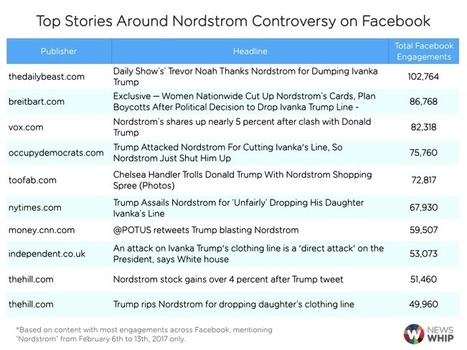


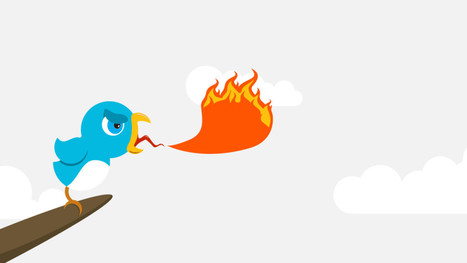

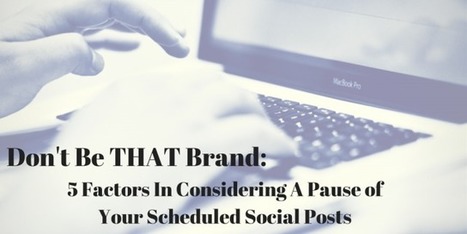
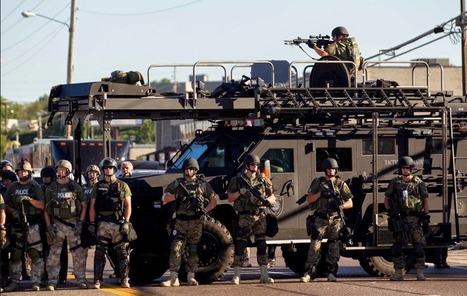


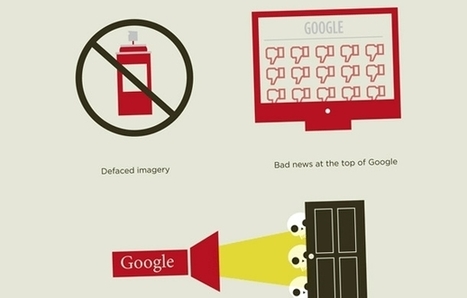





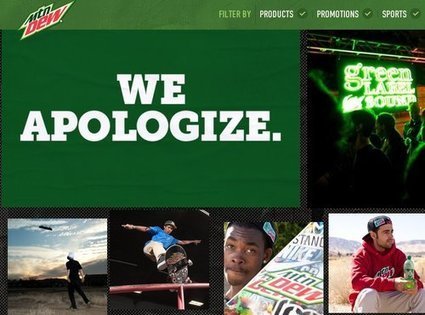
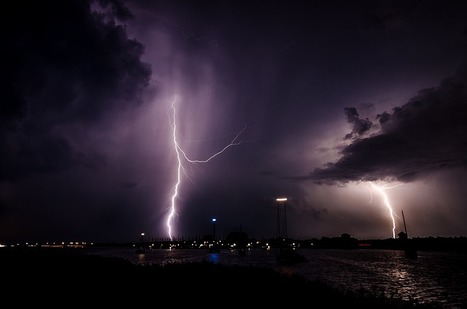

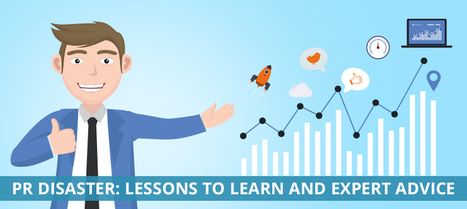



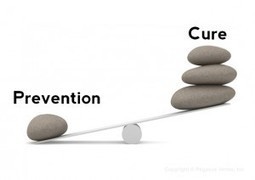
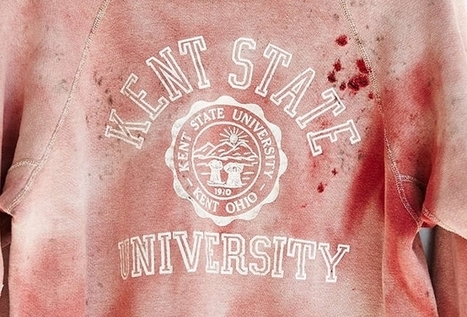
















What can brands and publishers expect from a political mention? NewsWhip dives into the latest controversy, around Nordstrom and how it played out on social media.